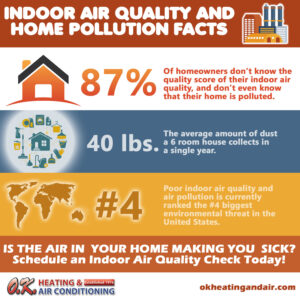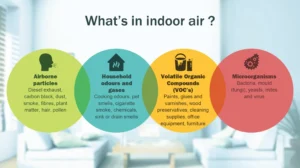February is National Care About Your Indoor Air Month, which makes this a great time to talk about the importance of indoor air quality testing. But you really should care about the indoor air quality of your home and workplace as well as your child’s school every day of the year.
“Over the last several decades concern over indoor air quality has grown and with good reason,” the folks at the National Air Duct Cleaners Association say. “On average, Americans spend 90 percent of their time indoors where, according to the EPA, the air can be 2 to 5 times more polluted than outdoor air.
Yes, you read that right – the air you breathe inside your home can be more hazardous to your health than the air you breathe in the great outdoors.
Most people think car fumes and the smoke billowing out of factory smokestacks are the biggest drivers of air pollution, but you probably have products inside your home that are releasing volatile organic compounds into the air.
“Things like burning candles, spraying hair spray, and using cleaning products can negatively impact your indoor air quality. Over time these contaminants, plus dust, dirt, and pet dander, can build up inside your air ducts where they can be recirculated through the air 5 – 7 times per day,” officials at the National Air Duct Cleaners Association say.
The Top 10 Indoor Air Quality Facts and Stats:
- 91% of the global population breathes heavily polluted air.
- About 7 million people die every year as a result of indoor and outdoor air pollution.
- Up to 3.8 million deaths occur annually due to smoke exposure from cooking fires.
- Pneumonia and ischaemic heart disease are the most common causes of premature death brought on by indoor pollution.
- Almost 3 billion people worldwide use stoves or open fires that pollute the air when cooking.
- The US’s air quality trends seem to have improved nationwide in the past four decades, according to air pollution statistics from the US.
- The yearly number of deaths caused by polluted indoor air has dropped by over a million over the last three decades.
- In 2016, 60% of the world had clean cooking fuels available.
- High-efficiency particulate air filters remove 99.97% of airborne bacteria, dust, mold, and pollen particles as small as 0.3 microns.
- The American indoor air quality market should hit $12.2 billion by the year 2023.
Importance of Indoor Air Quality
“Indoor air quality” refers to the quality of the air not just in a home, but includes also school, office, or other building environments. The potential impact of indoor air quality on human health nationally can be noteworthy for several reasons:
- Americans, on average, spend approximately 90 percent of their time indoors,1 where the concentrations of some pollutants are often 2 to 5 times higher than typical outdoor concentrations. 2
- People who are often most susceptible to the adverse effects of pollution (e.g., the very young, older adults, people with cardiovascular or respiratory disease) tend to spend even more time indoors. 3
- Indoor concentrations of some pollutants have increased in recent decades due to such factors as energy-efficient building construction (when it lacks sufficient mechanical ventilation to ensure adequate air exchange) and increased use of synthetic building materials, furnishings, personal care products, pesticides, and household cleaners.
91% of the global population breathes air that’s heavily polluted.
(WHO)
According to indoor air pollution facts, the World Health Organization says that air pollution represents a notable danger to the climate and people’s health. Based on areas where air pollution is monitored, over 80% of the urban population breathes poor-quality air, as per the WHO’s indoor air quality standards.
2. About 7 million people die every year as a result of indoor and outdoor air pollution.
(WHO)
According to the WHO’s indoor air quality statistics, low- and middle-income countries suffer the most from air pollution, including indoor and ambient air pollution. The combination of the two causes acute respiratory infections, heart disease, lung cancer, stroke, and more.
3. Up to 3.8 million deaths occur annually due to smoke exposure from cooking fires.
(EC Europa, NCBI)
According to statistics on air pollution, the developing world suffers from premature death and disease due to poor home indoor air quality. Households in low- and middle-income countries rely more on burning fires, including coal, dung, and wood.
They also rely on hazardous stoves that can produce a lot of pollutants, such as particulate matter, volatile organic compounds, and carbon monoxide. Contaminants like these can cause respiratory illnesses and even cancer.
4. The most dangerous indoor air pollutants include benzene, carbon monoxide, environmental tobacco smoke, formaldehyde, lead, naphthalene, and radon.
The European Commission deems these pollutants as the most concerning. It notes that more air pollution statistics from throughout the world should be gathered on their combined effects, thus allowing space for better indoor air quality regulations and guidelines.
5. Pneumonia and ischaemic heart disease are the most common causes of premature death brought on by indoor pollution.
(WHO)
Some indoor air quality statistics are bleak, but they must be brought to light. The leading causes of the 3.8 million deaths mentioned above are ischaemic heart disease (27%), pneumonia (27%), chronic obstructive pulmonary disease (20%), stroke (18%), and lung cancer (8%).


